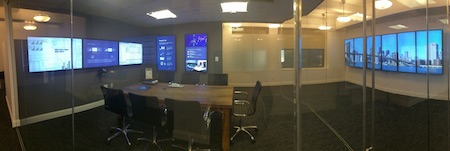Imagine sitting in a digital control room covered in flat panel screens. You take a device out of your pocket and beam an image onto a display, then hurl it across the room to a different screen with the wave of a hand. Your colleagues on the other side of the globe, with whom you’re chatting face to face, see it instantly. They respond, annotations appear on your image, and accompanying data sheets flash up in front of you.
The Mezzanine room at Oblong’s New York office.
This isn’t the conference room of the future; it’s the Mezzanine collaboration system by Oblong Industries, an exciting digital experience I was treated to on a recent visit to the company’s New York office. And the technology isn’t even new; it’s been around since 2012.
Designed by Oblong CEO John Underkoffler, who provided technical consultation for the futuristic digital interfaces in the 2002 film Minority Report, the Mezzanine system extends the concept of telepresence a step further, into the so-called realm of “infopresence.” In conjunction with live videoconferencing, all connected parties share a digitally interlocked meeting room, in which a wide array of content can be presented in real time, wirelessly, from almost any kind of internet device.
As Oblong’s regional sales manager, Darrin Montague, explained, what really sets the Mezzanine system apart from other collaboration platforms is its focus on information sharing. As we video chatted with Chicago-based director of communications Jen Uner, she and Darrin demonstrated just how easy the system makes informational exchange. With the video chat on the center screen of three displays that cover the front of the room, Darrin and Jen sent various content up to the two outer displays from a Mac, PC, and iPad. Additionally, two vertically oriented “corkboard” displays on the sidewall provided further space for information sharing. Overall, the immediacy and congruity of the conference between the New York and Chicago offices made it feel like we were actually sharing the same room.
But the most interesting feature, which elevates the Mezzanine system from a helpful business tool to an exciting, futuristic experience is the way it’s all controlled. Instead of using a mouse, or sensor-equipped gloves (like in Minority Report, but also a technology Underkoffler subsequently developed in reality), users command the interface with a wireless wand remote. Kind of like a Nintendo Wii remote with just one button, triangular prism-shaped wand operates a cursor that can grab images and move them from screen to screen around the spatially aware room. The wand can also be used to screen-grab images, or to interact with web pages just like a computer mouse.
Holding the wand, I was surprised by the level of spatial awareness built into the room. Once you hover the cursor over an item on screen and press the button to select it, you can simply pull the wand back toward your body to enlarge the image, or stab the wand forward to shrink it. Once selected, the image (or chart, video chat screen, pretty much anything) can be easily moved and pinned to any of the screens in the room, or the wall of vertically oriented displays beyond the glass enclosure of the room.
Designed primarily for executive briefing centers, customer experience centers, and high-value presentations, the Mezzanine system adds a level of cutting edge flair to what is, at heart, a productivity enhancement. When hosting clients discuss future developments, the Mezzanine delivers a “wow” factor that can transport a client out of the present and over the technological horizon. And it can do it all with almost no downtime – during our entire time at the office, there was hardly a wasted moment. Rather than having to physically plug and unplug inputs or USB drives, Mezzanine users can throw content up onscreen without leaving their seats.




